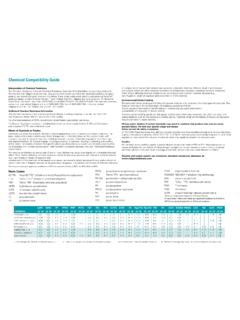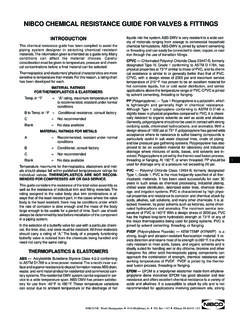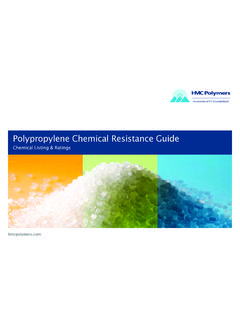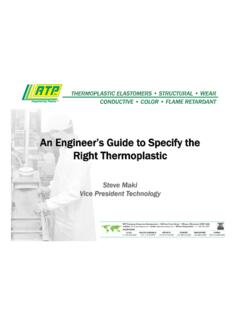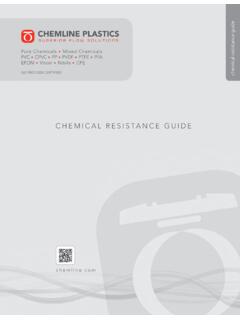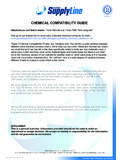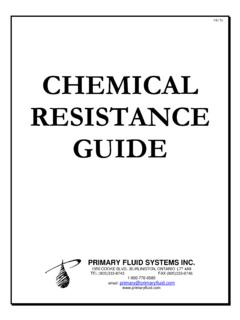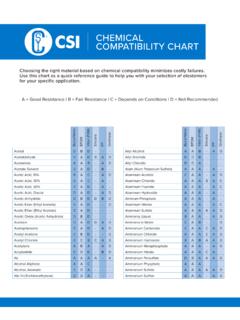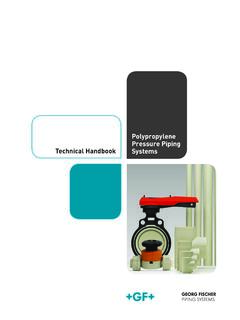Transcription of Chemical Compatibility Guide - Sevier Lab
1 Interpretation of Chemical ResistanceThe Chemical resistance Chart and Chemical resistance Summary Chart that follow are general guidelines for Thermo Scientific Nalgene products only. Because so many factors can affect the Chemical resistance of a given product, you should test under your own conditions. If any doubt exists about specific applications of Nalgene products, please contact Technical Service, Thermo Fisher Scientific, Nalgene and Nunc products, 75 Panorama Creek Drive, Rochester, New York 14625-2385, or call (800) 625-4327, Fax (800) 625-4363. International customers, contact our International Department at +1 (585) 899-7198, Fax +1 (585) 899-7195. In Europe, contact Nalgene at +44 (0) 1432 263933, Fax +44 (0) 1432 Chemical resistance InformationThis Chemical resistance chart is to be used for all labware including containers up to 50L.
2 For NALGENE centrifugeware please refer to those charts in this catalog. For Chemical resistance of PETG (polyethylene terephthalate copolyester), see below. For Nalgene fluorinated containers, including fluorinated high-density polyethylene (FLPE) and fluorinated polypropylene (FLPP), see inside back cover. Effects of Chemicals on Plastics Chemicals can affect the strength, flexibility, surface appearance, color, dimensions or weight of plastics. The basic modes of interaction which cause these changes are: (1) Chemical attack on the polymer chain, with resultant reduction in physical properties, including oxidation; reaction of functional groups in or on the chain, and depolymerization; (2) physical change, including absorption of solvents, resulting in softening and swelling of the plastic; permeation of solvent through the plastic,and dissolution in a solvent, and (3) stress-cracking from the interaction of a stress-cracking agent with molded-in or external stresses.
3 Also see Chemical resistance Classification .The reactive combination of compounds of two or more classes may cause a synergistic or undesirable Chemical effect. Other factors affecting Chemical resistance include temperature, pressure and internal or external stresses ( , centrifugation), length of exposure and concentration of the Chemical . As temperature increases, resistance to attack and/or dilution of certain chemicals in Nalgene labware can be potentially dangerous. The reactive combination of different chemicals or compounds of two or more classes may cause an undesirable Chemical effect or result in an increased temperature which can affect Chemical resistance (as temperature increases, resistance to attack decreases). Other factors affecting Chemical resistance include pressure and internal or external stresses ( , centrifugation), length of exposure and concentration of the Stress-CrackingEnvironmental stress-cracking is the failure of a plastic material in the presence of certain types of chemicals.
4 This failure is not a result of Chemical attack. Simultaneous presence of three factors causes stress-cracking: tensile strength, a stress-cracking agent and inherent susceptibility of the plastic to stress-cracking agents are detergents, surface active chemicals, lubricants, oils, ultra-pure water and plating additives such as brighteners and wetting agents. Relatively small concentrations of stress-cracking agent may be sufficient to cause and/or dilution of certain chemicals may result in reactions that produce heat and can cause product failure. Pre-test your specific usage and always follow correct lab safety : Please be aware that, although several polymers may have excellent resistance to various flammable organic chemicals and solvents, OSHA H CFR 29 for flammable and combustible materials, or other local regulations, may restrict the volumes of solvents which may legally be stored in an enclosed not store strong oxidizing agents in plastic labware except that made of FEP or PFA.
5 Prolonged exposure causes embrittlement and failure. While prolonged storage may not be intended at time of filling, a forgotten container will fail in time and result in leakage of contents. Do not place any plastic labware in a flame. Quickly and easily search our extensive Chemical resistance database at: Codes:ECTFE Halar ECTFE* (ethylene-chlorotrifluoroethylene copolymer)ETFE Tefzel ETFE (ethylene-tetrafluoroethylene)FEP Teflon FEP (fluorinated ethylene propylene)HDPE high-density polyethylene FLPE fluorinated polyethylene LDPE low-density polyethylenePC polycarbonatePEI polyetherimideFirst letter of each pair applies to conditions at 20 C; the second to those at 50 C. At 20 C->EG<-at 50 C. LDPE HDPE PP PPCO PMP PETG FEP TFE PFA ECTFE ETFE PC Rigid PVC Flex.
6 PVC PSF PS FLPE RESMER PMMA SAN PEI XLPE PVDFCHEMICAL 20 50 20 50 20 50 20 50 20 50 20 50 20 50 20 50 20 50 20 50 20 50 20 50 20 50 20 50 20 50 20 50 20 50 20 50 20 50 20 50 20 50 20 50 20 50 1,4-Dioxane, pure G F G G N N G F F N - - E E E E E E E F E F N N N N N N N N N N E E F N N N N N - - F N N N2,2,4-Trimethylpentane, pure F N F N F N F N F N - - E E E E E E E G E G N N N N N N G F N N G F G F - - - - - - - - E E2,4,6-Trinitrophenol, pure N N N N N N N N E E - - E E E E E E G F G F N N N N N N N N G F N N G F - - E E - - G N G N2-Methoxyethanol, pure E G E E G F E E E E F N E E E E E E E G E E N N F N F N N N N N E E G F - - N N - - - - E E2-Propanol, pure E E E E E E E E E E - - E E E E E E E E E E E E E F G N G F E G E E E E N N E F E E E E E EAcetaldehyde, pure G N G F G N G N G N - - E E E E E E G F E E N N N N N N N N N N G F G G N N N N N N N N N NAcetamide, saturated E E E E E E E E E E - - E E E E E E E E E E N N N N N N N N E E G G E E - - E E E - E E G NAcetic Acid, 5% E E E E E E E E E E F N E E E E E E E E E E E G E F E G E E E G E E E E E F E E E E E E E EE - No damage after 30 days of constant exposure.
7 G - Little or no damage after 30 days of constant exposure. F - Some effect after 7 days of constant exposure. N - Immediate damage may occur. Not recommended for continuous polyvinylidene fluorideRESMER RESMER manufacturing technologySAN styrene acrylonitrile TFE Teflon TFE (tetrafluoroethylene)TMX ThermanoxPMX PermanoxXLPE cross-linked high-density polyethylene *Halar is a registered trademark of Solvay Solexis. Or equivalent. Teflon and Tefzel are registered trademarks of DuPont. PPCO has replaced polyallomer (PA) in all polyethylene terephthalate copolymerPFA Teflon PFA (polyfluoroalkoxy)PMMA polymethyl methacrylate (acrylic)PMP polymethylpentenePP polypropylenePPCO polypropylene copolymerPS polystyrenePSF polysulfonePVC polyvinyl chlorideChemical Compatibility Guide Acetic Acid, 50% G F E G E E E E E E N N E E E E E E E G E E G F E N F N E E G G E G G G N N E F G F E E E E Acetic Acid, Glacial G N G G E G E G G G N N E E E E E E E E E E N N E N N N E E F N G G F N N N N N N N F N E G Acetic Anhydride, pure N N F F G F G F E G - - E E E E E E E E E E N N N N N N N N N N F F N N N N N N N N N N N N Acetone, pure G N N N F N N N E E N N E E E E E E E G G N N N N N N N N N N N F F F N N N N N F N N N N N Acetonitrile, pure E E E E E G F N F N - - E E E E E E E E E E N N N N N N N N N N E E F N N N N N - - N N G G Acetophenone.
8 Pure N N F F F N F N G N - - E E E E E E E E E E N N N N N N N N N N G G F N N N N N - - - - N N Acrylonitrile, pure E E E E F N F N F N - - E E E E E E E G E G N N N N N N N N N N E E F N - - - - - - E E G N Adipic Acid, pure E G E E E E E E E E - - E E E E E E E E E E E E E E E F G G E E E E E E - - E E - - E E E E Alanine, pure E E E E E E E E E E - - E E E E E E E E E E E E - - E G E E E E E E E E - - E E E E E E G N Allyl Alcohol, pure E E E E E E E E E G - - E E E E E E E E E E G G E N G N G F G F E E E E N N N N - - E E E G Aluminum Chloride, pure E E E E E E E E E E - - E E E E E E E E E E E G E E G G E E E E E E E E E E E G - - E E E E Aluminum Hydroxide, pure E G E E E G E E E G - - E E E E E E E E E E F N E E E G G G G G E E E E - - G G - - E E E E Aluminum Salts, pure E E E E E E E E E E - - E E E E E E E E E E E G E E E G E E E G E E E E - - E G - - E E E E Amino Acids, pure E E E E E E E E E E - - E E E E E E E E E E E E E E E G E E E E E E E E - - E E E E E E G N Ammonia, 25% E E E E E E E E E E - - E E E E E E E E E E N N E N G F E G E G F F E G E - E G G F E E N N Ammonia, pure E E E E E E E E E E - - E E E E E E E E E E N N E E G F G F E G F F E G E - E G G N E E N N Ammonium Acetate, saturated E E E E E E E E E E - - E E E E E E E E E E G G E E G N E E E E E E E E - - E E - - - - E E Ammonium Chloride.
9 Pure E E E E E E E E E E - - E E E E E E E E E E E G E E E G E E E E E E E E E - E E E E E E E E Ammonium Glycolate, pure E G E E E G E G E G - - E E E E E E E E E E G F E E G F G G E E E E E E - - E E - - - - E E Ammonium Hydroxide, 5% E E E E E E E E E E F N E E E E E E E E E E F N E E E G G G E F F F E G E - E E E G E E E E Ammonium Hydroxide, 30% E G E E E G E G E G N N E E E E E E E E E E N N E E G F G G G F F F E G E - E G G N E E E E Ammonium Oxalate, pure E G E E E G E G E G - - E E E E E E E E E E E E E E G N E E E E E E E E - - E E - - E E E E Ammonium Salts, pure E E E E E E E E E E - - E E E E E E E E E E G G E E E G E E G G E E E E - - E G - - E E E E Amyl Alcohol, pure E E E E E F E E G F - - E E E E E E E E E E G F E N G N E E G F E E E E N N E N E E E E E E Amyl Chloride, pure N N F N N N N N F F - - E E E E E E E E E E N N N N N N N N N N G F F N - - N N - - N N E E Aniline, pure E G G F E G G F G F - - E E E E E E G N E G N N N N N N N N N N G F F N N N N N E E F N E F Aqua Regia, pure N N N N N N N N N N - - E E E E E E E G E G N N N N N N N N N N N N N N - - G N N N N N G N Arsenic Acid, pure G F E E E E E G E E - - E E E E E E E E E E E E E E G G - - E E E E E E - - - - - - E E E E Benzaldehyde, pure E G G N E G E G E F - - E E E E E E E F E F N N N N N N F N N N G N F N N N N N F N N N F N Benzenamine.
10 Pure E G G F E G G F G F - - E E E E E E G N E G N N N N N N N N N N G F F N N N N N - - F N E F Benzene, pure N N N N N N N N N N N N E E E E E E E G E G N N N N N N N N N N F F F N N N N N F N N N E E Benzoic Acid, saturated E E E E E G E G E E - - E E E E E E E E E E E G E G E G F F G G E E G G E E E E - - N N E E Benzol, pure N N N N N N N N N N N N E E E E E E E G E G N N N N N N N N N N F F F N N N N N F N N N E E Benzyl Acetate, pure E G E E E G E G E G - - E E E E E E E G E G F N N N N N N N N N E E F N - - N N - - - - - - Benzyl Alcohol, pure N N F N G G N N G G N N E E E E E E E E E E N N G F F N N N N N G G F N N N G N - - - - E E Boric Acid, pure E E E E E E E E E E N N E E E E E E E E E E E E E E G G - - E E E E E E - - E E - - E E E E Bromine, pure N N F N N N N N N N - - E E E E E E E G E G F N N N N N N N N N F N N N N N N N G G N N E E Bromobenzene, pure N N N N N N N N N N - - E E E E E E G N E F N N N N N N N N N N F F F N - - N N - - - - E E Bromoform, pure N N N N N N N N N N - - E E E E E E G F E F N N N N N N N N N N F F F N - - N N N N - - E E Butadiene, pure N N F N N N N N N N - - E E E E E E E E E E N N F N N N N N N N G F G F - - N N - - - - E E Butyl Acetate, pure G F G F F N G F F F - - E E E E E E E G E G N N E N N N N N N N E G - - N N N N G N F N F N Butyl Chloride, pure N N N N N N N N F N - - E E E E E E E E E E N N F N N N N N N N F F
